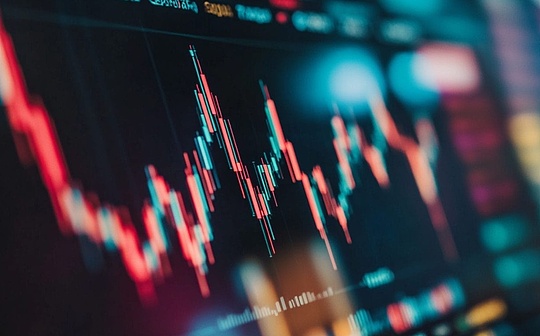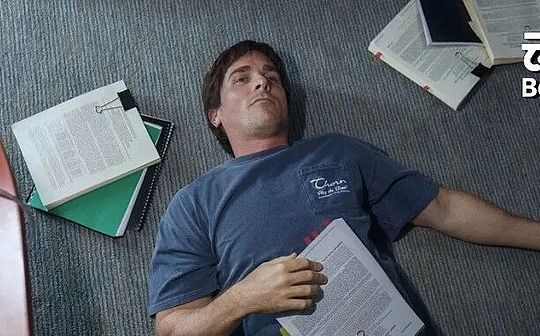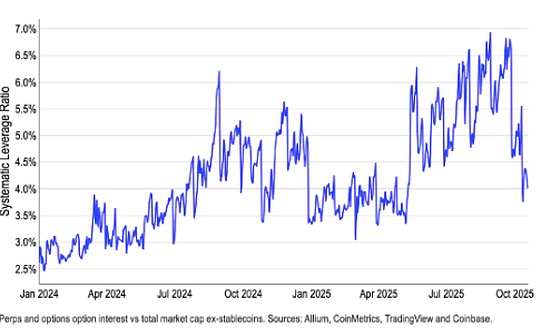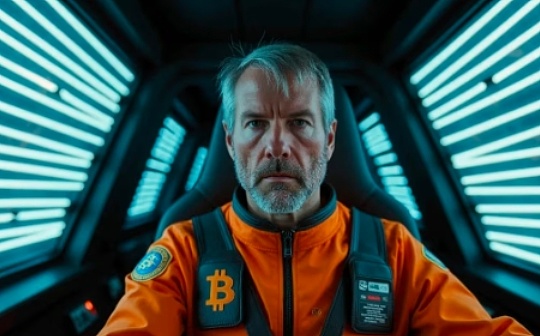
Source: CoinDesk; Compilation: Deng Tong, Bitchain Vision
summary
-
Strategy Chairman Michael Saylor predicts that by 2045, Bitcoin will become a $200 trillion asset class and transform it into a global settlement layer in the AI-powered Internet era.He believes that the U.S. adoption of Bitcoin strategic reserves will consolidate its dominance and force it to adopt it globally.
-
Strategy (formerly MicroStrategy) has used $33 billion to accumulate over 500,000 bitcoins, using innovative financial tools such as convertible bonds and preferred stocks to fund its corporate bitcoin vaults, and has financially designed a self-sustaining price increase cycle.
-
Saylor said destroying his Bitcoin holdings would bring “economic immortality.”
This is 2045.Digital assets flow at the speed of light.Artificial intelligence agents interact millions of times per second, using Bitcoin as the base currency.Bitcoin is now a $200 trillion asset class, the settlement layer in the era of Internet artificial intelligence.
This is the future envisioned by Michael Saylor, Bitcoin evangelist and executive chairman of Strategy (MSTR).Saylor pioneered the Bitcoin enterprise financial system—turning his shaky software company into a $85 billion leveraged Bitcoin giant listed on the Nasdaq.
CoinDesk recently conducted a two-hour interview with Saylor, the ultimate extremist of Bitcoin, to analyze his vision for Bitcoin’s global domination.
Bitcoin has maintained a 26% increase since the election of U.S. President Donald Trump, with a market cap peak of $2.1 trillion and hit an all-time high of $109,000 in January.Strategy is a Bitcoin proxy for Wall Street, and although Bitcoin fell about 30% from its November highs amid general declines in U.S. stock markets, U.S. 10-year Treasury yields and oil prices, it remained strong, with an increase of about 50%.
The United States has gone from regulating cryptocurrencies through law enforcement and secretly closing the banking business of digital asset companies (called “Operation Chokepoint 2.0” by the industry), to announcing that the United States will become a Bitcoin superpower and the world’s cryptocurrency capital.For Saylor, this huge change means that the previously closed door is opening.Governments and traditional institutional investors around the world who used to be afraid to get involved in digital assets are now curious about this.
Saylor said he is accepting invitations to speeches from all elite gatherings: 100 wealthiest families in South America, the Middle East Sovereign Wealth Fund, Morgan Stanley’s famous tech conference, CPAC and the White House.He changed from encouraging companies to adopt Bitcoin Treasury bills to recommending nation-states to establish strategic Bitcoin reserves.
He saidBitcoin has reached a “escape speed” because once the U.S. government starts actively buying Bitcoin, the U.S. will be a beneficiary and force every country to adopt Bitcoin as global capital.
“This has become a fait accompli,” Saylor said.“It’s one of the geopolitical initiatives, and when you embrace the network, you force all allies to adopt it first, and then all enemies must adopt it too.”
US Bitcoin strategic reserves
President Trump issued an executive order to establish the strategic reserve of US Bitcoin, which is a milestone in realizing the destiny of Bitcoin.The United States once held about 400,000 bitcoins, but sold half of them, making a profit of $366 million.Trump’s cryptocurrency Tsar David Sax lamented that the cost of U.S. taxpayers selling these bitcoins too early is $17 billion, by current market value.
The executive order directs the Treasury Secretary to never sell U.S. bitcoin and to develop budget-neutral ways to get more bitcoins.It further instructs the creation of a digital asset reserve, a seizure of crypto assets that can be managed and rebalancing as needed.
At President Trump’s White House Digital Assets Summit on March 7, Saylor proposed that the United States acquires 5%-25% of the total Bitcoin supply by 2035, which can generate about $100 trillion in economic value by 2045.
Asked about the proposal, Bo Hines, executive director of the President’s Digital Assets Advisory Committee, told CoinDesk that the Trump administration wants the U.S. to acquire bitcoin “as much as possible” and is considering a variety of creative approaches, including a proposal by Senator Cynthia Lummis (R-Wyo) to buy bitcoin using federal reserve earnings and gold certificates.
As the United States accepts Bitcoin, global banks will inevitably follow suit.
“Pandora’s box has been opened,” Saylor said.”When Bitcoin becomes popular… there will be trillions of dollars of digital capital in the banking system, and that will not be just in the United States. It’s a virus. So the virus will spread. In this case, it means you’ll have hundreds of thousands of banks and trillions of dollars, owned by a billion people.”
“Reasonable Thermodynamics” currency
Saylor was born in Lincoln, Nebraska.He grew up in air bases throughout the Midwest, as well as in Japan and New Zealand.The Air Force Scholar sent Sail to MIT, where he earned a double degree in Aeronautics, Aerospace and Science History.As a true rocket scientist, Saylor’s systematic thinking attracted him to Bitcoin’s “thermodynamic rationality” design.
After serving as Air Force Reserve Captain, Saylor co-founded MicroStrategy, a software company that flourished in the internet bubble in 1989 until 2000 when Saylor and two other MicroStrategy executives were involved in an accounting fraud scandal.Eventually, they reached a settlement with the SEC for about $11 million.
At MicroStrategy, Saylor invented more than 48 patents and deployed dozens of business ideas.Some succeeded, but most failed.Saylor said that ironically, his greatest success was the creativity of others.Bitcoin’s anonymous creator Satoshi Namamoto created “digital gold” and Saylor discovered it during the quarantine period during the COVID-19 pandemic.He grabbed it desperately, preferring MicroStrategy to die quickly than to die slowly after failure.
In July 2020, MicroStrategy began buying Bitcoin steadily and continuously through cash flow, equity and debt, basically any way it can use.It climbed to the high of the 2021 bull market and withstood the impairment fees of the 2022 cryptocurrency winter.By 2024, the financial strategy of Bitcoin enterprises has withstood the test of actual combat.It passed the first cryptocurrency market cycle, and Trump’s shock leaped MicroStrategy from a $1 billion company to a $100 billion company.
“[Bitcoin] became an opportunity,” Saylor said.“And then it became a strategy and then suddenly over the last 12 months we realized it was a very good business.”
From micro-strategy to strategy
MicroStrategy changed its name to “Strategy” and began to conduct business under the name “Strategy”.It turns out that it is a very ideal investment product for institutional investors who want to participate in Bitcoin volatility.Last December, Strategy was included in the Nasdaq 100 index.Currently, the company is considering joining the S&P 500 index, which will trigger another wave of open market access.
To create a positive momentum, Strategy focuses on raising funds through large amounts of fixed-income securities to buy more Bitcoin, creating a financial product casino for traders who are addicted to Bitcoin volatility.By constantly weighing market conditions, adjusting yield parameters and conversion factors, Strategy designed “smart leverage” to attract demand and ensure that each series of securities amplifies each other in an endless loop of positive feedback.
“If you say, it sounds like financial engineering, it’s definitely financial engineering,” Saylor said.“This puts more pressure on pushing up the price of Bitcoin, which in turn pushes up the price of MSTR, pushes up the leverage of MSTR, pushes up the value of options, pushes up the demand for equity, pushes up the demand and value of [convertible bonds], pushes up the price and demand of preferred stocks.”
Strategy raised about $33 billion through this financial project to buy 500 million bitcoins.This has sparked online debate about Strategy’s ability to pay dividends or bonds to maturity when the market deteriorates or fails to raise new capital.The money may not come from existing company cash flow: Strategy’s software profit is trivial, according to MarketWatch; in 2020-2023, the profit was negative.
All of this makes Saylor sleepless all night.Therefore, Strategy retains all options.
“When the equity capital market gives us a huge premium, we sell equity,” Saylor said.”If our leverage ratio is too high, we will deleverage. If we feel that the capital market is really not suitable for selling any securities, we will stop and wait.”
Last week, Strategy used the proceeds from the sale of MSTR common stock to buy an additional 6,911 bitcoins for $584 million, bringing its Bitcoin holdings to more than 500,000 tokens.They further announced that their new STRF permanent offering raised $711 million to buy more Bitcoin, and its initial goal was to raise $500 million.
This latest preferred stock series is different from the original STRK offering because it has a higher coupon rate (10% versus 8%) and there are no common stock conversion terms.Both companies clearly list risk factors, including no obligation to pay the accumulated dividend “for whatever reason”.
The strategy also eliminates any collateralized debt, thus eliminating the liquidation risk of the company’s Bitcoin assets.
“We have built an indestructible balance sheet. Bitcoin could fall 99%. There is no margin notice. The tools built do not have Bitcoin as collateral,” Saylor said.
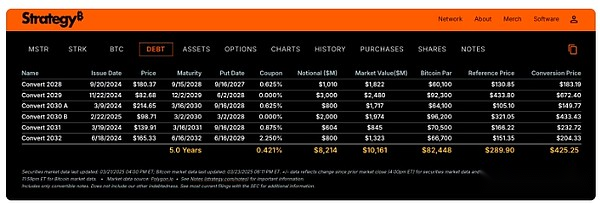
Strategy’s debt: convertible bonds and maturity dates.
Ultimately, the date worth noting is the expiration date of the loan Strategy offers to bondholders.The first “expiry date” is September 16, 2027.If Strategy fails to incentivize bondholders to convert bonds into MSTR stocks or convince them to wait for the second year to repay principal, those bondholders may ask Strategy to buy back its $1.8 billion loan in cash.If the market is still eager for Bitcoin investment, it will be easier to raise funds and repay investors.If the market is down and Wall Street’s money flow drys up, Strategy may have to consider selling its bitcoin or defaulting.

Strategy Chairman Michael Saylor AI Portrait
“Economic Eternal Life”
Saylor said Strategy, like the U.S. government, “never sells” its Bitcoin.He bets everything on the eternal rise in Bitcoin prices and the ideal sovereignty, sound currency, freedom and property rights that the community has idealized.
Before his death, Saylor might burn bitcoin instead of donating his assets.That would be a “more moral and more reasonable form of charity” and would give “economic immortality.”
“If I believe this and burn these keys, then I’ll make everyone on the Bitcoin network richer and stronger,” Saylor said.”We’re all together from now to forever. So, yes, that’s my legacy.”




